Staffing and recruitment are essential pillars of human resource management, directly impacting an organization’s success. While often used interchangeably, Staffing and Recruitment differences need to be understood properly. Staffing focuses on fulfilling all workforce requirements within an organization, while recruitment is concerned with attracting and selecting candidates. It involves creating job descriptions, advertising positions, and engaging with prospective applicants to build a pool of qualified candidates. While recruitment is a crucial step in the staffing process, staffing itself involves a comprehensive approach to managing an organization’s workforce to achieve its strategic objectives.
What is Staffing?
Staffing is a comprehensive process that encompasses workforce planning, acquiring, developing, and retaining employees. It aims to ensure that the organization has the right talent in the right roles at the right time.
Key Features of Staffing
Staffing extends beyond hiring, covering performance management, training, and retention.
- Workforce Planning: Identifies current and future personnel needs based on organizational strategies.
- Talent Acquisition: Goes beyond recruitment to focus on creating a sustainable talent pipeline.
- Onboarding and Integration: Ensures new hires adapt quickly to the organizational culture and processes.
- Employee Development: Offers training and upskilling opportunities to enhance productivity and engagement.
What is Recruitment?
Recruitment is a targeted process within the staffing framework, focusing on attracting, identifying, and hiring candidates to fill current job vacancies. It is the initial step in acquiring talent for an organization.
Key Features of Recruitment
Recruitment focuses on identifying, attracting, and hiring individuals to fill specific job vacancies. It is a targeted process within the broader staffing framework
- Job Analysis: Clearly defines the roles, responsibilities, and qualifications required for a position.
- Sourcing Candidates: Uses platforms like job boards, social media, and referrals to attract applicants.
- Screening and Selection: Evaluate candidates’ qualifications, experience, and cultural fit through interviews and assessments.
- Tech-Driven Approach: Relies on tools like Applicant Tracking Systems (ATS) for managing applications and improving hiring efficiency.
Staffing and Recruitment Difference
Staffing and recruitment are fundamental components of human resource management, yet they serve different functions within the hiring process.
| Aspect | Staffing | Recruitment |
| Definition | Involves a comprehensive process to manage the workforce, including planning, hiring, training, and retaining employees. | Focuses specifically on attracting, screening, and hiring candidates to fill job vacancies. |
| Scope | Broader scope, covering all activities related to managing the workforce lifecycle. | Narrow scope, limited to sourcing and hiring candidates for specific roles. |
| Objective | Ensures the organization has the right talent in the right roles, aligned with long-term goals. | Aims to fill immediate job openings with suitable candidates. |
| Duration | Continuous and ongoing process throughout the organization‘s lifecycle. | Time-bound ends once the position is filled. |
| Processes Involved | Includes workforce planning, talent acquisition, onboarding, training, performance management, and retention. | Limited to job analysis, sourcing, screening, selecting, and onboarding. |
| Focus | Emphasizes both qualitative and quantitative aspects of workforce management. | Primarily quantitative, focusing on the number of candidates hired. |
| Responsibility | Typically overseen by HR managers and workforce strategists. | Handled by recruitment teams or agencies specializing in hiring. |
| Tools and Techniques | Uses advanced tools like HRIS (Human Resource Information Systems) for workforce planning and management. | Relies on applicant tracking systems (ATS) and job boards for candidate sourcing. |
| Outcome | Results in a well-rounded, high-performing workforce that supports organizational goals. | Fulfills immediate staffing needs by hiring individuals for open positions. |
| Cost Implication | Involves ongoing investments in employee development and retention programs. | Requires a one-time investment for specific hiring campaigns. |
Types of Recruitment
The types of recruitment are categorized in ways to suit an organization’s hiring goals, resource availability, and nature of job roles. Here’s a comprehensive breakdown of various types of recruitment:
Active Recruitment
Active recruitment is a very proactive approach as organizations seek candidates actively to fill vacant job positions. This way of recruitment involves using different platforms such as job boards, social media, career websites, and recruitment drives that connect with potential candidates.
- Benefits: Quick remedy for the immediate need in the workforce and appeals to a wide variety of candidates.
- Challenges: Huge resources and effort in processing the high volume of applicants.
Passive Recruitment
This focuses on passive recruitment, which includes those who are not looking for jobs but would be interested in a good opportunity. These potential candidates form an organization’s pipeline of people for potential future hiring needs.
- Benefits: High-quality candidates access; they are often persons with special skills or professional experience.
- Challenges: This is a laborious process that may not offer quick returns.
Campus Recruitment
Campus recruitment involves hiring fresh graduates or interns directly from educational institutions. Organizations visit colleges and universities to identify young, talented individuals who can be molded into future leaders.
- Benefits: It provides access to a large pool of people who are enthusiastic and eager to work. It may reduce hiring costs because more roles are entry-level types.
- Challenges: Sometimes, candidates lack industry knowledge and require intensive training programs.
Executive Recruitment
Executive recruitment is a process that recruits senior-level professionals or executives, such as CEOs, CFOs, or directors. This process is generally outsourced to professional headhunters or executive search firms.
- Benefits: It ensures that the organization gets highly qualified and competent leaders who align with its vision and objectives.
- Challenges: The process is time-consuming and costly, often involving confidentiality and detailed background checks.
Types of Staffing
Staffing strategies differ according to the organization’s workforce needs, the duration of employment, and the nature of roles. Each type meets distinct objectives, ensuring the right fit for immediate goals and long-term goals.
Permanent Staffing
Permanent staffing involves hiring employees for long-term roles within the organization. These employees become part of the company’s payroll and receive a full range of benefits, including health insurance, retirement plans, and paid leave.
- Benefits: Increases the loyalty of an employee toward the institution since he becomes a kind of an owner and helps to make institutional knowledge.
- Challenges: The full range of benefits given to employees increases the cost of the company.
Temporary Staffing
Temporary staffing refers to hiring employees for a short duration to meet specific project needs, seasonal demands, or unforeseen workforce shortages. Temporary staff can be directly hired or sourced through a staffing agency.
- Benefits: It saves the cost of benefits and long-term liabilities. It helps companies react rapidly to market changes.
- Challenges: Temporary workers are less likely to be committed to the organization and need extra monitoring.
Contract Staffing
Contract staffing is an agreement to employ a worker on a temporary basis to undertake specific tasks or jobs. It is formalized in a contract specifying the duration, duties, and wages.
- Benefits: Offers the opportunity to hire experienced people for short-term projects. Saves overhead costs such as benefits and long-term salaries.
- Challenges: Contract employees may not be in line with the company’s culture and long-term goals.
Strategic Staffing
Strategic staffing is a forward-looking approach that aligns workforce planning with the organization’s long-term objectives. It emphasizes not only filling current roles but also preparing for future challenges by identifying critical skill gaps and building a talent pipeline.
- Benefits: Builds a sustainable workforce, reduces turnover, and ensures leadership continuity. It helps the organization adapt to industry changes.
- Challenges: Requires significant planning and investment in employee development and retention programs.
Staffing and Recruitment Difference FAQs
What is the role of technology in staffing and recruitment?
Technology streamlines processes like candidate screening, workforce planning, and employee performance tracking through tools like ATS and HRIS.
How does Staffing impact recruitment strategies?
Recruitment aligns with long-term staffing goals, focusing on sustainable talent acquisition and retention practices.
What are the challenges in staffing and recruitment?
Challenges include skill shortages, high turnover rates, and maintaining diversity in hiring.
Why is internal recruitment beneficial?
Internal recruitment saves time and cost, boosts employee morale, and ensures cultural alignment.
How do staffing strategies affect organizational success?
Effective staffing strategies improve productivity, reduce costs, and align workforce capabilities with business objectives.


